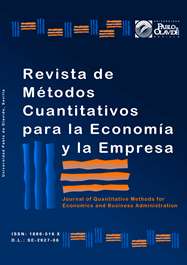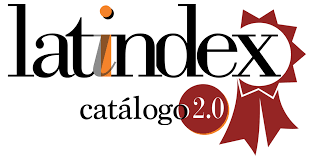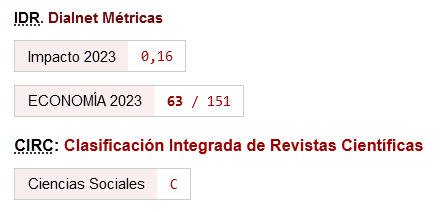El impacto de las fluctuaciones del precio del petróleo en el poder de préstamo bancario en Irán: una aplicación del enfoque GMM
DOI:
https://doi.org/10.46661/revmetodoscuanteconempresa.5537Palabras clave:
shock del petróleo, poder de préstamo bancario, economía iraní, Método de Momentos GeneralizadoResumen
La abundancia de recursos petroleros y la dependencia del presupuesto estatal de las exportaciones de petróleo crudo han expuesto la economía de un solo producto de Irán a las fluctuaciones del precio del petróleo y sus consecuencias. Por otro lado, de acuerdo con el sistema financiero del país y su bancarización, uno de los sectores que se ve constantemente afectado por las fluctuaciones del precio del petróleo es el sistema bancario y su desempeño. Con este fin, el presente estudio investigó el impacto de las fluctuaciones del precio del petróleo en el poder de préstamo de los bancos especializados en Irán utilizando datos estacionales de 1999 a 2018 utilizando el Método Generalizado de Momentos (GMM). Los resultados de este estudio indican que durante el período bajo revisión, las fluctuaciones del precio del petróleo han tenido un efecto negativo y significativo (coeficiente de -0.01) en el crecimiento del crédito de los bancos especializados. Asimismo, el crecimiento del PIB y la inflación han tenido, respectivamente, un efecto positivo y negativo (coeficientes de 0,09 y -0,09) sobre el poder crediticio de los bancos especializados durante el período analizado.
Descargas
Citas
Alodayni, S. (2016). Oil Prices, Credit Risks in Banking Systems, and Macro-Financial Linkages across GCC Oil Exporters. International Journal of Financial Studies, 4(4), 1-14.
Arellano, M., & Bond, S. (1991). Some Tests of Specification for Panel Data: Monte Carlo Evidence and an Application to Employment Equations. The Review of Economic Studies, 58 (2), 277-297.
Baltagi, B.H. (1995). Econometric Analysis of Panel Data (Vol. 2). New York: Wiley.
Baum, C.F., Caglayan, M., & Ozkan, N. (2005). The second moment matter: The response of bank lending behavior to macroeconomic uncertainty. http://www.gla.ac.uk/media/media_22217_en.pdf
Behzadi, M. (2015). The effect of symmetrical fluctuations in oil prices on the overdue receivables of the Iran's banking network. (Master's Thesis). Islamic Azad University, Tehran Branch, Iran.
Boyd, J.H., Levine, R., & Smith, B.D. (2001). The impact of inflation on financial sector performance. Journal of Monetary Economics, 47(2), 221-248.
Chan, Y. S., & Kanatas, G. (1985). Valuations and the Role of Collateral in Loan Agreements. Journal of Money, Credit and Banking, 17(1), 84-95.
Finn, M.G. (2000). Perfect Competition and the Effects of Energy Price Increase on Economic Activity. Journal of Money, Credit and Banking, 32(3), 400-416.
Foos, D., Norden, L., & Weber, M. (2010). Loan growth and riskiness of banks. Journal of Banking & Finance, 34(12), 2929-2940.
Greene, W.H. (2003). Econometric Analysis. New Jersey: Pearson Education.
Hamilton, J.D. (1983). Oil and the Macroeconomy since World War II. Journal of Political Economy, 91 (2), 228-248.
Heidari, H., Sadeghpour, S., & Dehghandorost, M. (2017). The Relationship between Inflation Uncertainty and the Bank Loan Facilities Granted. Monetary & Financial Economics (Previously Knowledge & Development), 24(14), 135-154.
Hosseini, E., & Rezagholizadeh, M. (2011). Analysis of the Fiscal Sources of Inflation in Iran Giving Special Emphasis to Budget Deficits. Quarterly Journal of Sustainable Growth and Development (Previously Quarterly Journal of Economic Research), 10(1), 43-70.
Idris, I.T., & Nayan, S. (2016). The Joint Effects of Oil Price Volatility and Environmental Risks on Non-Performin Loans: Evidence from Panel Data of Organisation of the Petroleum Exporting Countries. International Journal of Energy Economics and Policy, 6(3), 522-528.
Karimkhani, A.A., & Forati, M. (2012). Investigating the effect of macroeconomic variables on banks' resources and expenditures. Sepah Bank, Risk Research and Control Department.
Khandelwal, P., Miyajima, K., & Santos, A. (2016). The Impact of Oil Prices on the Banking System in the GCC. IMF Working Paper, 16/161. https://www.imf.org/external/pubs/ft/wp/2016/wp16161.pdf
Khodadadi, F., & Mehrara, M. (2017). Effect of macroeconomic fluctuations on the lending behavior of commercial banks in Iran. Journal of Islamic Economics & Banking, 6(18), 23-39.
Lashkary, M., Bafandeh, S., Hasannia, N., & Goli, A. (2015). Effects of Macroeconomic Variables on the Lending Behavior of Bank Maskan of Iran. Quarterly Journal of Sustainable Growth and Development (Previously Quarterly Journal of Economic Research), 15(3), 119-134.
Lee, C.C., & Lee, C.C. (2019). Oil price shocks and Chinese banking performance: Do country risks matter? Energy Economics, 77, 46-53.
Lee, C.C., Lee, C.C., & Ning, S.L. (2017). Dynamic relationship of oil price shocks and country risks. Energy Economics, 66, 571-581.
Mehrara, M., & Mojab, R. (2010). The Links between Inflation, Inflation Uncertainty, Output and Output Uncertainty in Iran. Journal of Monetary and Banking Researches (Previously Journal of Money and Economic), 1(2), 1-30.
Mehrara, M., Taiebnia, A., Dehnavi, J. (2013). Determinants of Inflation in Iran Based on STR Approach. Journal of Economic Research (Tahghighat-e-Eghtesadi), 47(4), 221-242.
Olokoyo, F.O. (2011). Determinants of Commercial Banks’ Lending Behavior in Nigeria. International Journal of Financial Research, 2(2), 61-72.
Said, A. (2015). The Influence of Oil Prices on Islamic Banking Efficiency Scores during the Financial Crisis: Evidence from the MENA Area. International Journal of Finance & Banking Studies, 4(3), 35-43.
Saif-Alyousfi, A.Y., Saha, A., & Md-Rus, R. (2018). Impact of oil and gas price shocks on the non-performing loans of banks in an oil and gas-rich economy: Evidence from Qatar. International Journal of Bank Marketing, 36(3), 529-556.
Sameti, M., Dalali, R., & Karnameh, H. (2012). The Impact of Macroeconomic Instability on the Banking Sector Lending Behavior in Iran (1974-2009). Trend of Economic Research, 19(60), 5-28.
Shayhaki, M., & Khorram, T. (2017). The Relationship between Unemployment Rate, Oil Price and Interest Rate in Iran. Quarterly Journal of the Macro and Strategic Policies, 4(16), 115-134.
Somoye, R.O.C., & Ilo, B.M. (2009). The Impact of Macroeconomic Instability on the Banking Sector Lending Behaviour in Nigeria. Journal of Money, Investment and Banking, 7, 88-100.
Talavera, O., Tsapin, A., & Zholud, O. (2006). Macroeconomic Uncertainty and Bank Lending: The Case of Ukraine. DIW Discussion Papers, 637. https://www.econstor.eu/bitstream/10419/18530/1/dp637.pdf
Xu, C., & Xie, B. (2015). The Impact of Oil Price on Bank Profitability in Canada. (Master's Thesis). Simon Fraser University, Canada. http://summit.sfu.ca/system/files/iritems1/15821/Xie%2C%20Bingqing%20and%20Xu%2C%20Chengcheng.pdf
Zomorrodi, M., & Golshahi, M. (2017). The effect of oil price changes on the amount of non-current facilities of banks: A case study of Iran. 27th Annual Conference on Monetary and Currency Policies (Financial Stability, the Basis of Sustainable Economic Growth). Tehran: IRIB International Conference Center.
Publicado
Cómo citar
Número
Sección
Licencia

Esta obra está bajo una licencia internacional Creative Commons Atribución-CompartirIgual 4.0.
El envío de un manuscrito a la Revista supone que el trabajo no ha sido publicado anteriormente (excepto en la forma de un abstract o como parte de una tesis), que no está bajo consideración para su publicación en ninguna otra revista o editorial y que, en caso de aceptación, los autores están conforme con la transferencia automática del copyright a la Revista para su publicación y difusión. Los autores retendrán los derechos de autor para usar y compartir su artículo con un uso personal, institucional o con fines docentes; igualmente retiene los derechos de patente, de marca registrada (en caso de que sean aplicables) o derechos morales de autor (incluyendo los datos de investigación).
Los artículos publicados en la Revista están sujetos a la licencia Creative Commons CC-BY-SA de tipo Reconocimiento-CompartirIgual. Se permite el uso comercial de la obra, reconociendo su autoría, y de las posibles obras derivadas, la distribución de las cuales se debe hacer con una licencia igual a la que regula la obra original.
Hasta el volumen 21 se ha estado empleando la versión de licencia CC-BY-SA 3.0 ES y se ha comenzado a usar la versión CC-BY-SA 4.0 desde el volumen 22.










